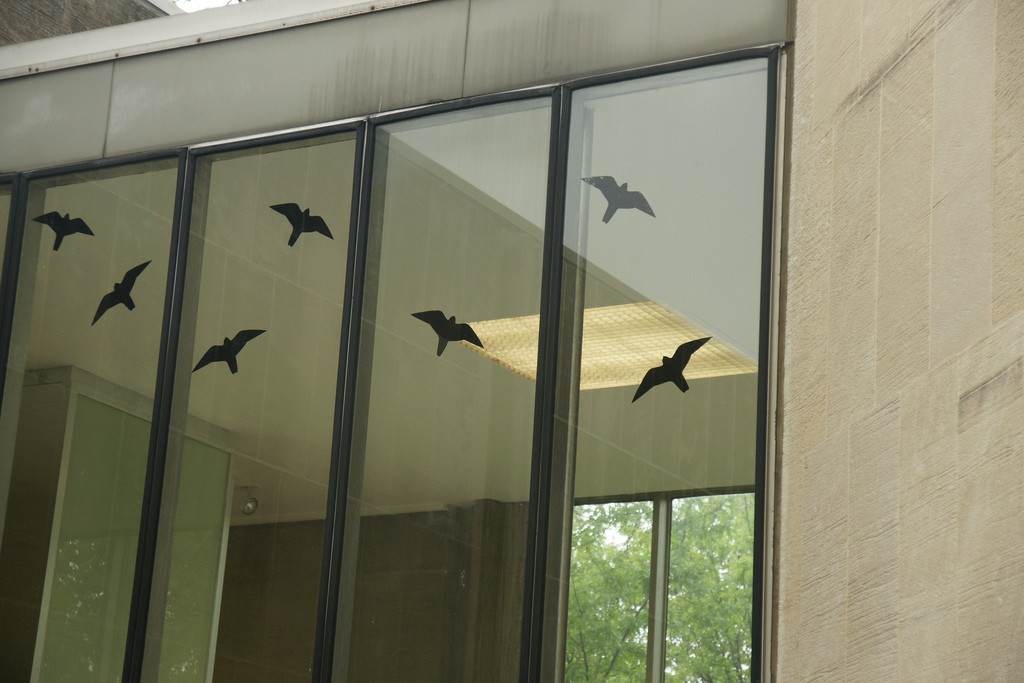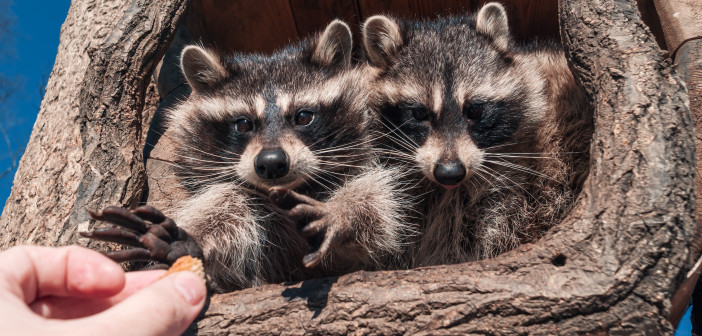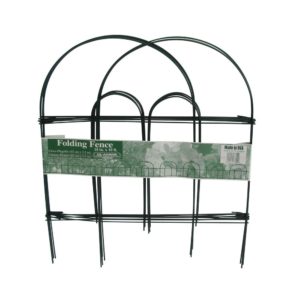Once you’ve created an urban backyard habitat for wildlife, it’s best to let the animals enjoy it without too much disturbance. That isn’t to say we shouldn’t step right out and continue our human activities—erect a swing set, play with our children, enjoy a barbecue, or have a yard party. It just means we’re now carrying on side-by-side with lots of skittish wildlife we’ve intentionally invited, so we should stay mindful of the consequences of human interference and potential hazards for them. Here are seventeen tips that will help you keep your yard safe for the wildlife that visit it.
Don’t feed leftovers
Force wild animals to forage for their food in the “wilds” of your yard by critter-proofing your trash container. The enticing smell of dinner leftovers—a mound of chicken bones, a lump of mashed potatoes, a half-eaten piece of buttered bread—will beckon wildlife from far and near. Raccoons, those smart devils, are able to simply lift off an unsecured lid and throw open the gates of heaven to opossums and any other animals that can climb in there with them. Even deer will graze in your garbage, if possible. Some of our human food isn’t good for wildlife. Deer are attracted to bread and sweets, for example, but those foods can cause dangerous digestive problems for them.
Foiling a trashcan thief
Dispose of leftover food in a garbage disposer, if possible. Many trash hauling companies provide containers to their customers with lids that can be secured. If you’re using another kind of container, it may take some imaginative trial and error to outwit a cunning raccoon. A tight-fitting lid may do the trick, but don’t count on it. You can place a brick on top as a weight to hold the lid down, but even this may not be enough. Maybe two bricks will do, or a chain run from one handle across the lid to the other handle. Or, keep the trashcan in your garage.
No plates on the porch
In addition to raccoons, expect opossums, skunks, foxes, rodents, even Coyotes, and others to visit your yard. They would love nothing more than a plate of your dinner leftovers placed on the porch for them. Please resist the temptation. This puts them too close to humans. Wildlife occasionally carry diseases and they also can be dangerous. Even mild-mannered, gentle opossums may feel forced to fight if cornered. Wildlife can become pests through no fault of their own and in unpredictable ways.
Keep cats away
If you allow your cat outside, be aware that the danger to wildlife significantly increases. Cats, including the sweetest, most loving, and well-fed domestic ones, kill millions of small animals every year. It isn’t maliciousness; it’s just what they do. Not only do their teeth kill, but their saliva does, too, because it carries a usually fatal bacteria, Pasteurella, that attacks an animal’s central nervous system. Any hapless creature that manages to escape from a cat’s mouth will probably die from it.
A bell on your cat’s collar won’t work. A cat’s slow hunting behavior is too smooth to ring the bell until it’s too late for the prey. Even if it does ring, an animal doesn’t intuitively know to associate the sound with imminent danger. (Domestic cats that are allowed to go outdoors have shorter lives. Here are all the many good reasons why.)
Locate bird feeders strategically
If cats visit your yard, keep bird feeders away from shrubbery, overhanging tree limbs, decks, and anywhere else a cat can hide in, under, or upon, unless you’re willing to take extra precautions. For example, you can help safeguard birds at feeders by placing fencing that’s one or two feet (30–61 cm) tall just under the spread of nearby shrubs. This doesn’t prevent cats from lurking there, but it does stop them from pouncing forward onto a bird. Either the cat must lie in plain sight in front of the fencing, or behind it, which forces it to jump up and over, rustling the foliage. The sound will alert the bird, and it also slows the cat down by a split second, and that’s all the time a bird needs. You can apply the same strategy around ground-level birdbaths.
Short, wire fencing is available at local hardware stores in green powder-coating, making it long-lasting and inconspicuous. It’s also inexpensive. It doesn’t need posts; just push the metal legs into the ground.
- Birds are an important and entertaining addition to your wildlife habitat. It’s fun to draw them in close to windows for easy viewing. Consider, however, before hanging a bird feeder from the overhang of your house or on a window ledge that fallen seeds attract mice.
Warn birds away from your windows
Window glass is invisible to birds. Flying birds, watching ahead of themselves, see trees and shrubbery, or an open field, or clear blue sky, only to discover too late it’s a reflection of where they’re coming from, not where they’re going to. Millions fly full-bore into window glass. Half the birds who hit windows die. The experts at Allaboutbirds.com report that up to a billion birds die from window collisions each year.
Tips for preventing collisions
| • Lower the shades on windows that seem to be highly reflective and causing collisions. That may be enough to prevent mishaps. Oftentimes, it’s not. |
| • If you have double-hung windows, use window screens. They will help soften the impact of any collisions and give birds some visual perspective. |
| • Hang streamers in front of windows and glass doors (on the outer side). |
| • Tape strips of Mylar 10 inches (25 cm) apart on the outside of the glass. You can also use hanging string, feathers, or even stained glass art outside the window. |
| • Add muntin bars. Also called grilles or windowpane dividers, they make a single window look like it consists of several separate panes of glass. |
| • Static-cling bird or butterfly silhouettes are available at garden centers and birdseed stores. The idea is to place them on the outside of windows to break up the reflected image and draw the bird’s attention to the glass. The Audubon Society says this isn’t effective unless you space them about two inches (5 cm) apart. |
| • AllAboutBirds.com suggests hanging netting on the outside of casement windows and doors that lack exterior screens. Draw it very tight so it acts as a springboard, of sorts. Leave a space of about 3 inches (7.6 cm) between the glass and the netting. |

According to AllAboutBirds.com, the decals on these windows should be placed closer together (Romana Klee / Flickr; CC BY-SA 2.0)
Don’t destroy beneficial and harmless insects
Almost all insects are beneficial or, at the very least, benign. Try not to destroy them. If possible, plant duplicate plants to which you can relocate bothersome caterpillars. It seems kind to move a caterpillar from a plant and place it carefully on the ground, rather than killing it. But, caterpillars feed on species-specific plants, so removing them from those usually results in their starvation. Most caterpillars we see are future butterflies and moths.
Pick up litter
Seemingly innocuous items can be dangerous to wildlife. Animals are known to stick their heads through plastic six-pack connectors while foraging, then be unable to remove them. Kite string and monofilament fishing line can become tangled around an animal, crippling it. Fishing hooks can be embedded in a foot or mouth. The ways that trash can torture and kill wildlife are limitless.
Cover window wells
Animals can fall into window wells, doomed to die there by a slow death of starvation or dehydration. Customized window well covers are costly, but home improvement stores carry inexpensive, ready-made plastic covers. They’re lightweight and can be pushed upward or easily broken in case of emergency, so they’re not a hazard for your family. Another option is to build a simple wood frame of lumber or lattice and fasten window screening across the top.
Check before mowing or trimming trees
Walk your yard before mowing or rototilling to look for baby rabbits and ground-nesting birds, still in their nest. If you find some, keep a wide berth until the young ones have left. Look in bird and squirrel nests and in cavities before trimming trees. If you see nestlings, it’s only a matter of weeks or even days before the young ones will fledge, and you can get back to your trimming.
Clean up spills
If oil gets on a bird’s feathers, they lose their insulating properties, leading to hypothermia and death. Antifreeze is deadly, but attractive to many animals (including your family pets) because it has a sweet taste.
Ban synthetic fertilizers and all pesticides
All pesticides and synthetic fertilizers are poisons. Even “organic” pesticides can be dangerous; read the label before using them.
Don’t raise or keep wildlife
Wild animals don’t make good pets, they don’t like being pets, and in most states, it’s illegal.
Screen chimneys, vents, and hidey-holes
Destruction of their habitat has forced wildlife to face hard challenges, one of which is finding suitable shelter in an environment of turfgrass, concrete, and sparse plantings. Who can blame them for grabbing any reasonable offering?
Install chimney caps and vents to bar occupancy in fireplaces and attics by squirrels, birds, bats and raccoons. If you believe a critter is living under a shed or other outbuilding, just leave it be. Except for skunks, what does it matter? If the lodger is nocturnal, it’ll stay tucked in, snoozing during the day, or if it’s inclined to come out, it won’t while you’re in the yard. Never seal a hole without first making sure it’s empty.
Dealing with pests
Pest problems usually can be controlled. But if a critter becomes a pest and nothing you do solves the problem, call in a licensed wildlife rehabilitator, a wildlife sanctuary, or an experienced animal trapper who will humanely catch the animal and release it elsewhere. Call animal control only as a last resort—in most areas, it’s a death sentence, as they’re required to euthanize the animals they catch. How to humanely remove wildlife from people spaces
Teach children to respect animals
Children should be taught that all wildlife play a valuable role on earth. How to humanely remove wildlife from people places






